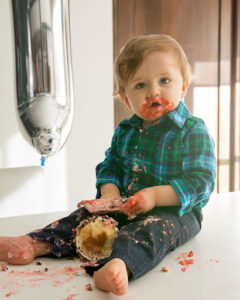
Have you ever had the feeling that something went down the “wrong pipe?” This is a common sensation that people feel when food or liquid accidently enters their airway instead of traveling to their stomach. Most of us are able to protect our airways by coughing up any material that goes down the wrong way. However, some children are unable to cough up material that enters their airway, putting them at greater risk for material entering their lungs, otherwise known as aspiration. Feeding your child can already be a stressful experience, especially when it comes to their safety. Therefore, it is important to understand the signs, symptoms, and risk factors that are associated with aspiration to identify when it is appropriate to seek medical attention.
What is aspiration?
Aspiration is when food, liquid, saliva, or any other foreign item enters the airway or lungs. Aspiration can occur in infants, children, and adults, and can vary from mild to severe. If persistent and untreated, aspiration can lead to serious health issues, such as pneumonia.
What are the risk factors for aspiration in infants and children?
Aspiration is most commonly caused by a swallowing disorder, otherwise known as dysphagia. Other risk factors for aspiration include, but are not limited to:
- Abnormal anatomy, such as cleft palate, paralyzed vocal folds, or esophageal atresia
- Premature birth and related complications
- Reflux disorders
- Neurological disorders
- Other medical diagnoses, such as Down Syndrome
What are the signs and symptoms of aspiration in infants and children?
Aspiration can result in overt signs/symptoms, such as:
- Coughing or choking during feeds
- Wheezing and/or breathing problems (stop breathing or fast breathing)
- Voice sounds wet or gurgly after feeding
- Signs of distress, including facial grimacing, tearing of the eyes, arching back, or redness in the face
- Repeated lung or airway infections
- Slight fever after meals
Aspiration can also occur withoutovert signs of swallowing difficulty, meaning that the child does not cough or show symptoms when material goes into their lungs. This is known as silent aspirationand is best detected by a formal video-swallow study, as it cannot be observed by the naked eye.
What can I do?
If your child is demonstrating ANY signs or symptoms of aspiration, notify your speech-language pathologist or contact your medical provider to discuss the need for a formal swallow evaluation. After a swallowing evaluation, your medical team will be able to determine which consistencies are safest for your child to eat and drink, as well as create a plan of care to improve your child’s swallow function.
Questions or concerns?
If you have questions or concerns about the safety of your child’s swallow, please contact us at info@playworkschicago.com or 773-332-9439.
Jill Teitelbaum, MS, CF-SLP
Speech-Language Pathologist
Reference: Aspiration in Babies and Children. (2018). Retrieved from https://www.cedars-sinai.org/health-library/diseases-and-conditions—pediatrics/a/aspiration-in-babies-and-children.html
Photo Credit: Jens Johnsson via unsplash.com















 Do you fear letting your baby get messy? Can’t stand the sight of food in their hair or on the floor and dread the work that it means for you afterwards? You are not alone! Lots of parents have a really hard time allowing their baby to be a complete and total mess while eating. But did you know that this mess is more than just a headache for you later on? It is actually a critical learning experience for your little one! So next time you cringe at the sight of your toddler flinging applesauce across the room or your baby dropping yet another yogurt-covered spoon on the floor, remember that you are helping their development.
Do you fear letting your baby get messy? Can’t stand the sight of food in their hair or on the floor and dread the work that it means for you afterwards? You are not alone! Lots of parents have a really hard time allowing their baby to be a complete and total mess while eating. But did you know that this mess is more than just a headache for you later on? It is actually a critical learning experience for your little one! So next time you cringe at the sight of your toddler flinging applesauce across the room or your baby dropping yet another yogurt-covered spoon on the floor, remember that you are helping their development.